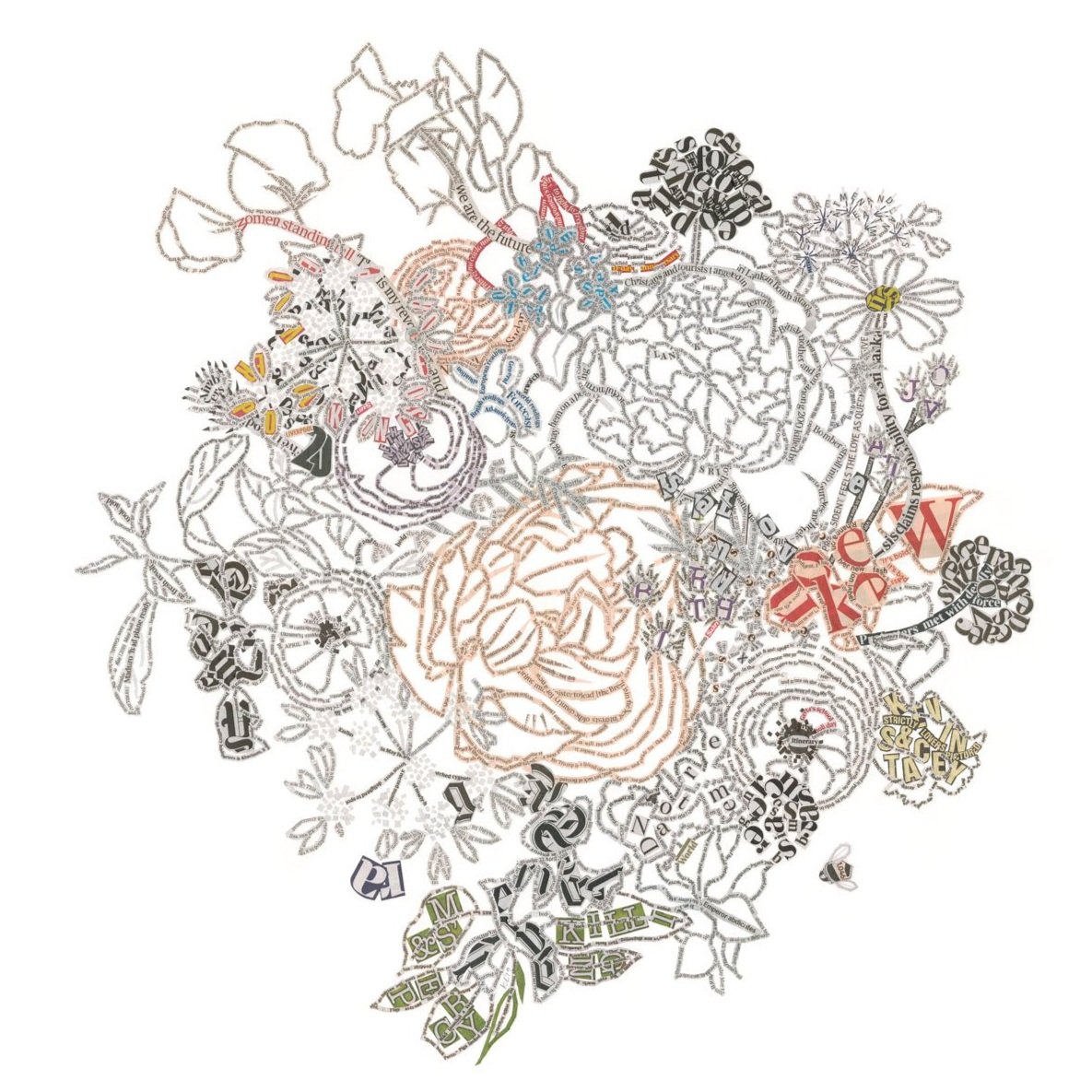
Kate Lewis processes the news via intricate botanical collages created directly from newsprint.
“This all started Spring 2018 when I could not take any more news. I was going about my daily domestic life: walking the dog, doing a food shop, watching the seasons change while bombs are going off and disasters are happening that I have no relation to or control over.”
Kate found herself—quite literally—dissecting the news; going back to basics with scissors, newspaper, and glue as a way of processing the state of world affairs. What began as a calming act of low-tech creativity has resulted in a beautifully multilayered and subconscious fusion of nature, current events, design and media.
The flower—a fleeting beauty—signifies places and seasons. They are present for all of our major life events: births, deaths, weddings, birthdays.
At first glance, you see a beautiful image of a flower, but upon closer examination the story emerges—fragmented pieces of history, staccato words, a familiar font, a sly bit of irony, the symbolism of the bloom.
“The wreaths are time capsules. Read the stories. Despite source material that is as literal as a newspaper story these works shine a new light. Jokes and jolts lie in hiding. Look at the juxtaposition of events. The profound sits next to the absurd. Like life itself. There is no hierarchy to the stories but there are subtle typologies of font and flora at work that begin to slowly reveal themselves. Words and colours that are displaced from their original context take on a new form in leaves and stems.”
— John Kieffer
When I saw one of Kate Lewis' floral newsprint wreaths for the first time it was love at first night, even before I fully understood what was happening with the artworks. Pictures made of text! For someone who had spent an unreasonable amount of time over the years poring over works like Tom Phillips' A Humument this was going to be good. Then a sense of appreciation moving towards awe started to develop as I was pulled into Kate Lewis' artworks. At a time when so much of what is called contemporary art just does or says one thing - if anything at all - these pieces were the opposite. There is so much going on and on so many levels in these works. Because of this, you can approach the pieces in very different ways.
There is of course the overall form. At first sight, these are ravishing and even before digging deeper into the text, it is possible to feel the presence of the seasons in these arrangements.
The wreaths are time capsules. Read the stories. Despite source material that is as literal as a newspaper story these works shine a new light. Jokes and jolts lie in hiding. Look at the juxtaposition of events. The profound sits next to the absurd. Like life itself. There is no hierarchy to the stories but there are subtle typologies of font and flora at work that begin to slowly reveal themselves. Words and colours that are displaced from their original context take on a new form in leaves and stems. And perhaps my favourite - a discombobulated bar code makes up the centre of a peony in Spring 2021.
You can slow down time. Contemplate or even meditate. Look for a while at a section of the artwork or the artwork as a whole and you have something that exists in a space somewhere between a mandala, the mystic spiral, a flower painting by Ambrosius Bosschaert the Elder, and the palm of your hand. You may stay there for a while.
These are though, time capsules, from what has been for many a strange, sad and difficult period. It is no surprise that Kate Lewis references Sartre to make sense of this time: “There may be more beautiful times but this one is ours.” She is finding patterns, reoccurrences, anomalies, trends, broad sweeps and tiny moments in the news and reflecting them at times as elegiac, at other times celebratory. There is nothing sentimental or whimsical in this work. It is beautiful, yes, but it is also tough and unflinching. What may seem like an innocuous stem in a story suddenly delivers an unexpected emotional punch that you did not see coming.
This series of artworks have an earthy kind of Britishness about them. The flowers are all native, as are the newspapers. We may well be approaching the endgame for print media, and it is hard to imagine that there will too many more artworks made with the stuff of the papers before the news goes entirely digital.
This is not magic though. It is work. You can see exactly how it was made. Paper. Scissors. Glue. Dedication. Time. Lots of time. Real work.
Words by John Kieffer






















